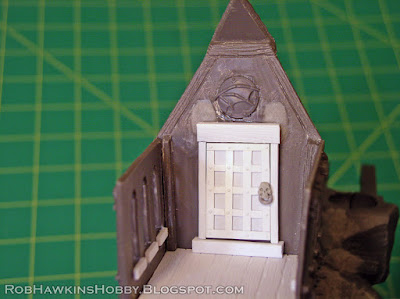With the main citadel construction finished, It's time to detail the interior of the tower. The task isn't as daunting as it seems; building interiors don't need to be very intricate because the intention is for models to fit inside. I need to cover the cavities, build the floor, and add just enough detail to make it convincing.
For the inside of the chimney, I use some bits of resin stone (these are from my Skull Forge Scenics graveyard wall set), and cut them into pieces to stack vertically up the wall over the gap. I'm not bothering with a fireplace; I'll just assume that the fireplace is on a lower level and its chimney is extending up past this room.
I etch a wood grain texture into the posts in the corners so they look like wooden structural beams.
For the floor, I use a piece of thick styrene card and carefully cut it to fit in the tower. It takes a bit of patience, cutting a little each time, checking the fit, and cutting more. I don't want to trim off too much and be left with a piece that's too small. The first rule of cutting is that you can always remove more material, but you can't add it back! Once the shape is correct, I score lines in it for the planks and then etch wood grain into them.
There needs to be a way to get up from the level below, so I make a small hatch. It's the same technique that I used on the floor– Score the boards and then etch the wood grain into a piece of styrene card. I make some hinges out of plastic rod and a random detail scavenged from somewhere for the handle.
I don't want to bother with framing the inside of the windows, but I add a sill to each window, made from a strip of styrene with wood grain etched into it.
I fill the depressions over the door with putty and build up the corners of the door frame.
For the door itself, I make a series of vetical strips and smaller horizontal strips to fit between them. Everything is scaled to match the size of the door on the outside of the tower. The strips are rivet-punched and glued to a thinner sheet of styrene.
For the rivets, I use a rotary hand sewing punch. It's the best tool for making scenery, because it allows me to add "rivets" to plastic card very quickly without cutting tiny "chads" and gluing them in place.
I mark the strips and make cuts into the card just enough so I can snap off the strip. Then, I mark where the rivets will be and use the punch to make a dimple in the plastic.
On the reverse side, this shows up as a rivet. Then, the strips are snapped off and glued in place.
Here's the finished door, with a skull and ring from a plastic chain to use as the handle. (Note: Make sure the handle is on the same side of the door so it matches up with the handle on the outside. I almost made that mistake!)
I finish up the door frame with different size L-strips, each scored with wood grain, and glued in place. I finish the wall by covering the hole with a decorative shield, and etch some wood beams along the roof line.
The chimney wall is attached and use putty to fill in the gap and enhance the flattened-out stone texture.
I had thought about magnetizing the roof, but it doesn't really need it. Once the two roof halves are glued together, it all sits in place pretty well.
The final step is to secure the little triangular roof bit and sculpt some stones over the remaining gap in the chimney.
Now my necromancers have a sanctum from which they can scowl at the neighborhood kids for making too much noise outside!
| Toht Nhemisis reenacts Mink Stole's scene from the film Desperate Living. |






















That interior really adds quite a bit to the look of the piece, particularly with all those windows.
ReplyDeleteWhat an excellent job, truly inspirational. I'm longing to see the next step
ReplyDeleteFantastic work!
ReplyDeleteYour attention to detail is so inspiring.
ReplyDeleteThanks a lot, guys!
ReplyDelete